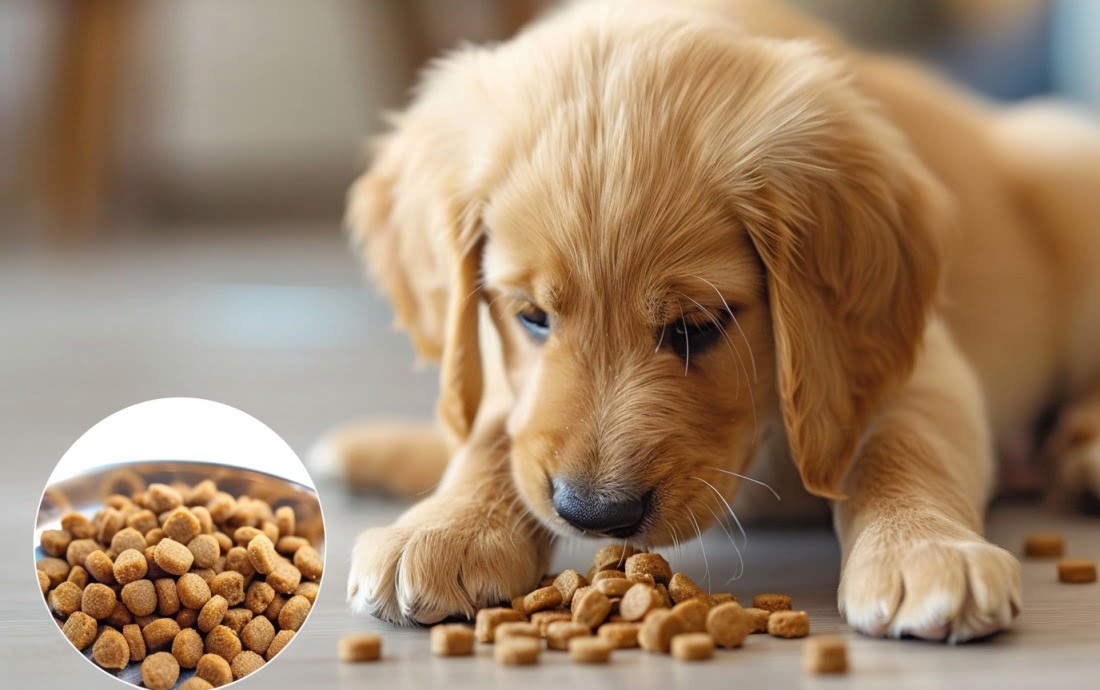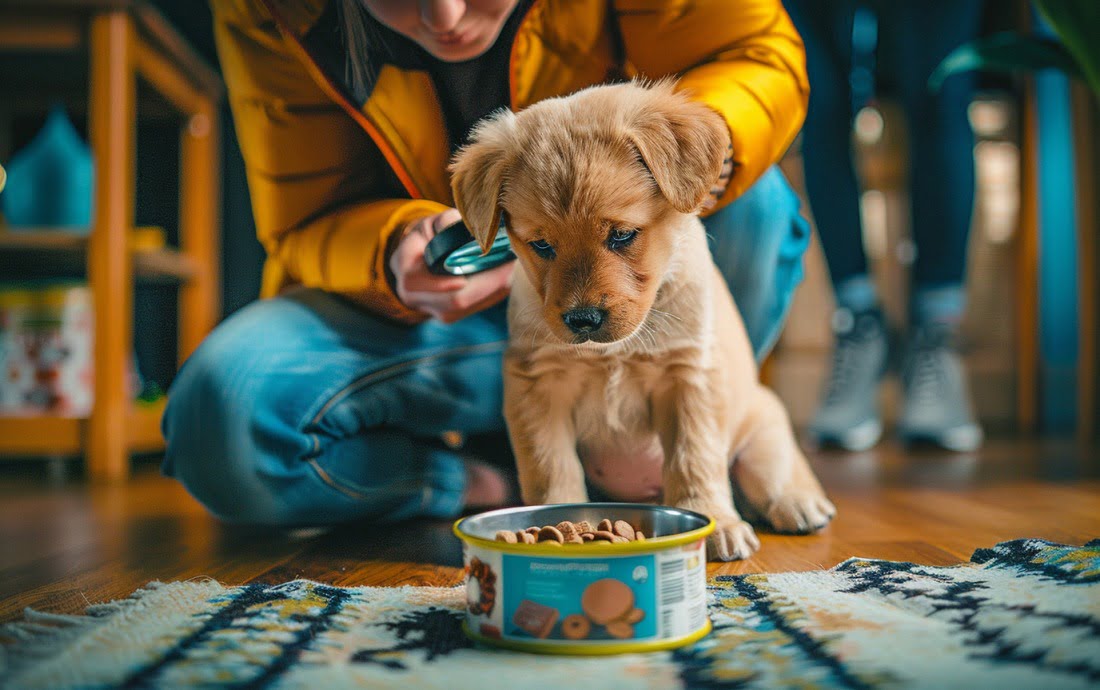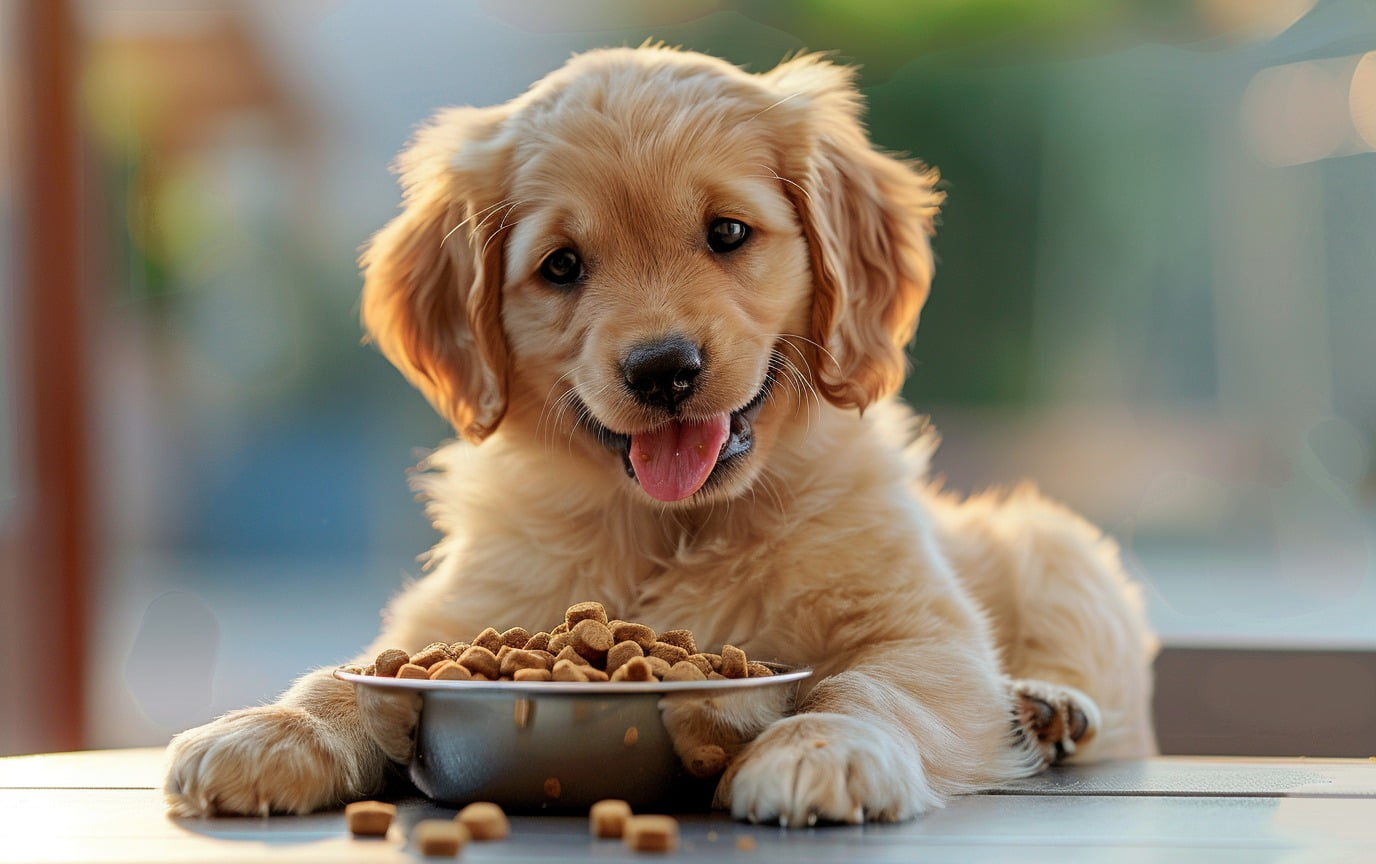Welcoming a new puppy into your home is a joyous occasion, filled with tail wags, sloppy kisses, and boundless energy. As a devoted pet parent, you want to provide the very best for your furry companion, especially when it comes to nutrition. Choosing the right puppy food is crucial for their growth, development, and overall well-being.
But have you ever wondered, “What is good puppy food?” It may seem like a simple question, but understanding the shelf life of your puppy’s food is essential for ensuring they receive the optimal nutrients they need to thrive.

In this comprehensive guide, we’ll delve into the world of puppy food, exploring the top 10 picks of 2024 according to the experts at MDogsW. We’ll discuss what to look for when choosing a food, how to decipher those sometimes confusing labels, and most importantly, how to ensure your puppy’s meals are fresh and safe. We’ll also answer those burning questions you might have about feeding your furry friend. So, let’s embark on this journey to find the perfect food for your growing pup!
Top 10 Best Puppy Foods for 2024: A Deep Dive into MDogsW’s Picks
Let’s take a closer look at the MDogsW’s top picks for puppy foods in 2024, considering their nutritional value, ingredient quality, life stage appropriateness, and even how they fare when it comes to the dreaded expiration date. Remember, this is a curated list, and your veterinarian can always provide personalized recommendations for your specific puppy’s needs.
| Rank | Brand & Variety | Key Features |
Expiration & Storage Tips
|
| 1 | Nom Nom Fresh Dog Food | Human-grade, fresh ingredients; customized meal plans; subscription service; high in protein; great for picky eaters |
Refrigerate upon arrival; freeze unused portions; check individual package expiration dates
|
| 2 | Ollie Fresh Dog Food | Similar to Nom Nom, but with more recipe variety; personalized portion sizes; focus on whole, unprocessed ingredients |
Same as Nom Nom
|
| 3 | Blue Buffalo Wilderness Puppy Chicken Recipe Grain-Free Dry Dog Food | High-quality protein from deboned chicken; no chicken by-product meals; contains DHA for brain and eye development; antioxidant-rich LifeSource Bits |
Store in a cool, dry place; check bag for expiration date; use within a few weeks of opening to maintain freshness
|
| 4 | Wellness Complete Health Puppy Deboned Chicken & Oatmeal Recipe | Balanced nutrition for all breed sizes; real deboned chicken as the first ingredient; contains probiotics for digestive health; no artificial colors, flavors, or preservatives |
Same as Blue Buffalo
|
| 5 | Instinct Original Grain-Free Recipe with Real Chicken Dry Puppy Food | High protein from cage-free chicken; freeze-dried raw coated kibble for palatability; grain-free option for sensitive stomachs; added probiotics and omega fatty acids |
Same as Blue Buffalo
|
| 6 | Canidae PURE Real Salmon & Sweet Potato Recipe Limited Ingredient | Single animal protein source (salmon); limited ingredients for sensitive stomachs; grain-free; no artificial colors, flavors, or preservatives |
Same as Blue Buffalo
|
| 7 | Purina Pro Plan Puppy Chicken & Rice Formula Dry Dog Food | Backed by research from Purina’s team of nutritionists; high-quality protein from chicken; DHA for brain and vision development; optimized calcium, phosphorus, and other minerals for strong bones and teeth; suitable for all breed sizes |
Same as Blue Buffalo
|
| 8 | Eukanuba Puppy Dry Dog Food | Tailored nutrition for different breed sizes; high-quality animal protein; DHA and ARA for brain development; prebiotics and beet pulp for digestive health |
Same as Blue Buffalo
|
| 9 | Royal Canin Size Health Nutrition Mini Puppy Dry Dog Food | Formulated specifically for small breed puppies; kibble size and texture adapted for smaller mouths; supports immune system development; balanced energy content for active puppies |
Same as Blue Buffalo
|
| 10 | Hill’s Science Diet Puppy Healthy Development Chicken & Barley | Clinically proven antioxidants for immune system support; optimal levels of DHA from fish oil for healthy brain and eye development; high-quality protein for lean muscle; no artificial colors, flavors, or preservatives; suitable for all breed sizes |
Same as Blue Buffalo
|
A Deeper Dive: Understanding “Best By” Dates and Storage
It’s important to note that most commercial dog foods have a “best by” date, not an expiration date. This means that the food is at its peak quality before that date, but it doesn’t necessarily go bad immediately after.
However, to ensure your puppy receives the most nutritious and safe meals:
- Always check the “best by” date before purchasing. Choose the freshest option available.
- Store opened dry food in a cool, dry place. An airtight container can help preserve freshness and prevent pests.
- Avoid storing food in humid areas or direct sunlight, as this can accelerate spoilage.
- Discard any food that looks or smells off. Trust your senses – if it doesn’t seem right, don’t risk feeding it to your puppy.
By following these tips and choosing a high-quality puppy food from the list above, you’ll be well on your way to raising a happy, healthy pup!

How to Choose the Right Puppy Food: A Step-by-Step Guide?
With so many puppy food options on the market, it can be overwhelming to choose the right one for your furry friend. But don’t worry, we’ve got you covered! Here’s a step-by-step guide to help you make an informed decision:
1. Consider Your Puppy’s Age and Breed Size:
Puppies have different nutritional needs at different stages of development. Small breed puppies may require a food formulated for their smaller mouths and higher energy needs, while large breed puppies need a diet that supports healthy bone and joint growth to prevent orthopedic problems later in life. Look for food that is specifically labeled for your puppy’s age and breed size.
2. Check for Allergies and Sensitivities:
Just like humans, puppies can have allergies or sensitivities to certain ingredients. If your puppy has any known allergies, choose a food that avoids those ingredients. Common allergens for dogs include chicken, beef, dairy, wheat, and corn. If you’re unsure, consult your veterinarian for guidance.
3. Assess Your Puppy’s Activity Level:
Is your puppy a couch potato or a high-energy adventurer? Active puppies need a diet with higher calorie and protein content to support their energy levels, while less active puppies may do better with a food formulated for weight management.
4. Read the Label Carefully:
- Look for a statement from the Association of American Feed Control Officials (AAFCO): This indicates that the food meets the minimum nutritional requirements for puppies.
- Check the ingredient list: The first few ingredients should be high-quality sources of protein, such as meat or fish. Avoid foods with fillers like corn, wheat, and soy, as well as artificial colors, flavors, and preservatives.
- Pay attention to the guaranteed analysis: This lists the minimum percentages of protein, fat, fiber, and moisture in the food.
Consider the “Best By” Date: Opt for the freshest food possible, and remember to store it properly to maintain its quality.
5. Consult Your Veterinarian:
If you’re unsure which food is best for your puppy, don’t hesitate to consult your veterinarian. They can help you choose a food that meets your puppy’s individual needs and dietary restrictions.
A Word on Homemade and Raw Diets:
Some pet parents opt for homemade or raw diets for their puppies. While these diets can be nutritious, they require careful planning and preparation to ensure they’re balanced and meet all of your puppy’s nutritional needs. If you’re considering a homemade or raw diet, consult with a veterinarian or a certified pet nutritionist for guidance.
Common Questions About Feeding Your Puppy: Everything You Need to Know
Feeding a puppy can feel like a whirlwind of questions, especially if it’s your first time raising a young dog. Let’s tackle some of the most common queries head-on, ensuring you’re well-equipped to nourish your little furball.
When and How Often Should I Feed My Puppy?
Puppies have tiny tummies but big appetites! Here’s a general guideline:
- 6-12 weeks: Feed your puppy four meals a day, spaced evenly throughout the day.
- 3-6 months: Reduce to three meals a day.
- 6-12 months: Transition to two meals a day.
- After 1 year: Most dogs thrive on two meals a day, but some smaller breeds may prefer three.
Consistency is key, so try to feed your puppy at the same times each day. This helps establish a routine and can also aid in house training.
How Much Food Should I Feed My Puppy?
The amount of food your puppy needs will vary depending on their age, breed, size, and activity level. Check the feeding guidelines on the dog food package, but remember, these are just starting points.
- Monitor your puppy’s weight and body condition: If your puppy is gaining too much weight, reduce the amount of food you’re feeding. If they’re too thin, increase the amount.
- Consult your veterinarian: They can help you determine the appropriate amount of food for your puppy based on their individual needs.
When Should I Switch My Puppy to Adult Food?
The transition to adult food should typically happen around 12-18 months of age, depending on your puppy’s breed and size. Large breed puppies may need to stay on puppy food for a longer period to support their slower growth rate. Gradually introduce the adult food over several days to avoid digestive upset.
How Can I Tell if My Puppy’s Food Has Expired?
Even the best puppy foods can go bad. Here’s how to tell if your puppy’s food is past its prime:
- Check the “Best By” Date: This is the most obvious indicator. If the date has passed, it’s time to discard the food.
- Look for Signs of Spoilage: Mold, an off-putting odor, discoloration, or changes in texture are all red flags.
- Trust Your Nose: If the food smells rancid or otherwise unappealing, don’t feed it to your puppy.
What Should I Do if My Puppy’s Food Has Expired?
If you discover that your puppy’s food has expired, discard it immediately. Do not attempt to salvage any portion of it, as feeding spoiled food can cause illness. Instead, replace it with a fresh bag of food.
Understanding “Best By” vs. “Expiration” Dates
- “Best By”: Indicates when the food is at its peak quality and nutritional value. While it may still be safe to eat after this date, it may not be as nutritious or palatable.
- “Expiration”: This date marks the point at which the food is no longer safe to eat. Never feed your puppy food that has reached its expiration date.

A photo of a healthy, happy adult dog with a playful puppy by its side
See more: 5 Best Iron Sources for Dogs- Boost Their Health Naturally
Conclusion
Choosing the best food for your puppy is an investment in their future health and happiness. By understanding their nutritional needs, reading labels diligently, and paying attention to expiration dates, you’re setting them up for a lifetime of vitality.
Remember, a high-quality diet, alongside regular veterinary care, exercise, and plenty of love, is the cornerstone of raising a thriving canine companion. The MDogsW’s top picks for 2024 provide a great starting point, but don’t hesitate to consult your veterinarian for personalized advice tailored to your puppy’s unique needs.
Your puppy’s health is a journey, not a destination. It’s a commitment to providing them with the nourishment they need to grow, learn, play, and become the best version of themselves. And with the right food and care, you’ll be rewarded with years of wagging tails, happy barks, and unconditional love.
FAQ
Can I mix different brands of puppy food to provide more variety?
While variety can be appealing, it’s best to stick with one brand and gradually transition if you need to switch. Mixing brands can lead to inconsistent nutrient intake and potential digestive upset for your puppy.
Is grain-free puppy food necessary, or is it just a trend?
Grain-free diets were popular, but there’s no evidence they’re necessary for all puppies. Some pups might have grain sensitivities, but for most, high-quality grain-inclusive foods are perfectly healthy. Consult your vet for personalized advice.
What are some red flags on puppy food labels that I should avoid?
Watch out for vague terms like “meat by-product” or “animal digest,” artificial colors and flavors, and excessive fillers like corn, wheat, or soy. Prioritize real meat as the first ingredient and a clear list of recognizable, whole foods.
How do I transition my puppy from their breeder’s food to a new brand?
Gradual transitions are key! Start by mixing a small amount of the new food with the old, gradually increasing the new food’s proportion over 7-10 days. This helps prevent tummy troubles and ensures your puppy accepts the new diet.
My puppy seems to inhale their food! How can I slow them down?
Fast eating can lead to choking or digestive problems. Try a slow-feeder bowl, spreading the food on a baking sheet, or feeding smaller, more frequent meals to encourage slower eating habits.

Healthy dogs mean happy dogs, and that makes me happy! I’m here to share all the tips for keeping your best furry friend in top shape, from puppyhood to their golden years.

